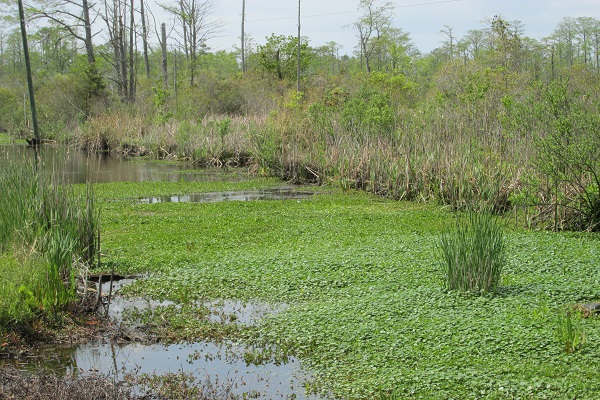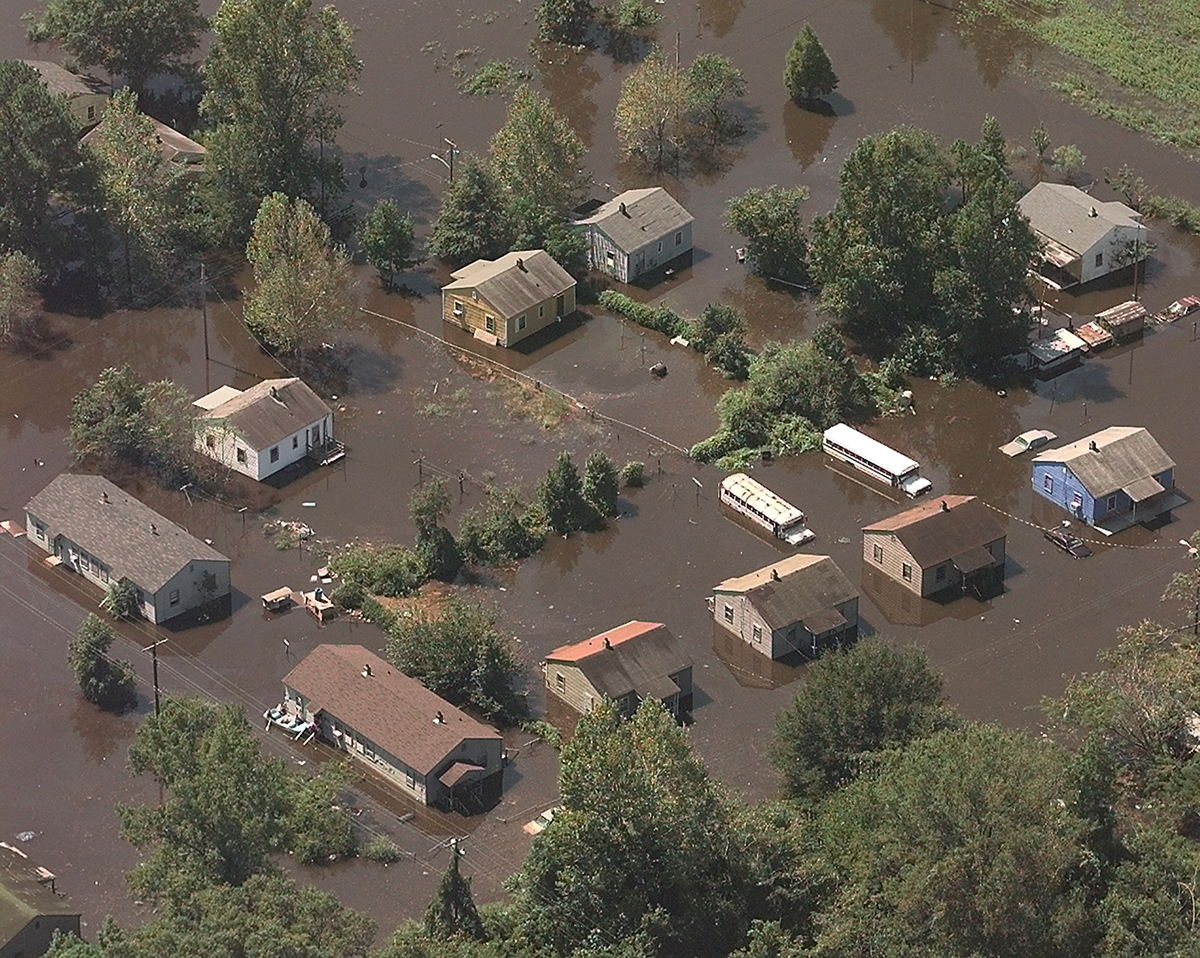Alligator Community Rich in Hunting, Fishing Traditions

While standing in a rain-soaked yard in the rural community of Alligator in Tyrrell County, Ray Sykes springs open a rusted trap used by his dad to capture raccoons.
“My dad and I would trap ‘coons and whatnots,” says Sykes. “During the season, we would trap every day. My old man, daddy could hunt, trap and kill ’em. He did not use bait. He just hunted them. Back in the old days, you’d get three ‘coons on a good day. It was best when it was dark, and the moon was not shining.”
Before the fur man came, Syke’s late father, Lonnie Frank Sykes, would stretch the hide of a raccoon or muskrat on a long cypress board.
“You would get $5 or $6 for each coon in the early 1970s and $35 for otter,” says Sykes. “The last few years, there hasn’t been much price on fur.”
For many years, trapping thrived in the undeveloped swamps and woodlands of the Alligator community — just off U.S. 64 between Columbia and Manteo.
When the hunting season was over, many residents turned to better-known coastal occupations — fishing, farming and forestry.
By the 1980s, trapping for a living began to dwindle in Alligator — which includes the tiny communities of Fort Landing, Pot Licker, Pledger Landing and Goat Neck as well as the Alligator Marina. However, many residents still hunt recreationally for bears, raccoons and deer.
When ‘coon hunting, Sykes carries a lantern, chains, ropes and a machete that he uses to help him mark the trails.
“I never burn a bright light but just use a lantern,” he says. “I don’t use a compass. As I go through the woods, I make a glace or mark with a machete on a tree. When I get in deep, I build a fire if it is cold.”
When hunting deer, Sykes goes with friends and neighbors to the Big Buck Hunting Club that leases property on the Palmetto Peartree Reserve from the Conservation Fund.
Holding up a steel hunter flag that alerts others when deer hunting, Sykes says that some members also run fox. “We have hunt masters who have lived and trapped on the land before and tell newcomers what to expect about water levels and other things,” he adds.
One of the hunt masters is Chatman Bryant of Goat Neck. “As an old hunter, I love to hear dogs run and bay,” says Bryant.
Bryant also likes to show off a handgun that he uses to kill bear.
“I killed many a bear with this gun,” says Bryant, who is retired from the N.C. Department of Transportation. “I do bear hunting off at Buffalo. When hunting bear, you get them in the corn field at night.”
STRONG FISHING TRADITION
Because of Alligator’s proximity to the Alligator River and Albemarle Sound, the tiny community has a rich fishing culture.
In the winter, people would set gill nets in the “little Alligator” — where the mouth of the Alligator River, Alligator Creek and Albemarle Sound join together — when herring were running, says Alligator native Syble Knotts.
“People would catch herring and then salt them up and can the roe,” she adds.
As the herring began to dwindle, more people turned to crabbing.
William Stott, who is compiling an oral history of crabbers in the Albemarle Sound, says there are some very successful crabbers in Alligator. Stodfs project is funded by the Blue Crab Research Program administered by North Carolina Sea Grant.
“Some crabbers also set eel pots and even do some striped bass net fishing,” adds Stott. “Some of the Alligator watermen I know — like Willy Phillips, and Pumell and David Gallup — are smart, hard-working professionals. They are adaptive and Innovative. I am deeply impressed by their work ethic, their intelligence and their good humor and spirit.”
A few in the Alligator community work the water full-time. Others, like Sykes, fish part-time. In front of his home, Sykes keeps some of his fishing gear, including crab pots, eel and catfish pots.
“I crab in the Alligator River,” says Sykes, who also works in construction. “The last two to three seasons, I have bought pots and put in escape rings. I have 300 to 400 pots in the Alligator River.”
In his many years of fishing and hunting in the swamps, Sykes says that he has never seen an alligator. However, others have spotted gators during the summer at East Lake, Whipping Creek and the canal at the Alligator Marina near the Alligator River Bridge.
“There is an alligator in Second Creek about two miles away from the marina, and it is about 16 feet long,” says Wanda Pritchett, co-owner of the Alligator Marina. “The ones up on Milltail Creek are not that big.”
COMMUNITY HISTORY
With only a small concentration of American alligators in the community, there are two theories of how the community got its name, according to Morris Pritchett, co-owner of the Alligator Marina.
“Some say it is because of the shape of the Alligator River,” he says while pointing to the river on a North Carolina map. “You see, the river turn is the tail, and the feet and head are at the top.”
The second theory is that years ago there was a large concentration of American gators near the swamps and marshes, adds Wanda Pritchett.
Although Native Americans inhabited parts of Tyrrell County in the 1500s, there is no recorded mention of the Alligator community until the 1800s when new homes appeared, according to Bridging Generations through Tyrrell County Memories by Virginia C. Haire, Lillian D. Hill, Madge L. Van Home and Gwen A. White.
“Gum Neck, Alligator, and other communities near the water grew,” according to the publication.
From the late 1800s through the 1950s, many in the Alligator community rotated how they made a living by the season, according to Al Hollis, who grew up in Fort Landing.
“In the fall, everyone participated in the hog killings,” says Hollis. “The men started the preparations around 5 a.m.,” he explains. “Then the men would cut up the meat. The women would wrap the meat in wax paper. People came from all over the community and helped.”
The highlight was the big dinner that culminated the raising of hogs, he adds.
When leaves began falling from trees, women would get together and rake yards, according to Hollis. And along the great shoals of the Alligator River, men would set their nets.
“There would be four or five groups at a time, and they would cook fish,” adds Hollis. “This is how they fed the family.”
During the winter, Hollis says his family tended to the livestock, and his grandfather trapped bears and racoons.
When spring arrived, the family got the fields ready to plant. “During the summers, we worked from sunup to sundown in the Irish potato fields,” says Hollis. “There would be a crew of 80 to 100 digging potatoes by hand.”
Because of the vast stretches of forests, many in Alligator also worked at lumber mills until the early 1940s.
Hollis remembers his father’s stories about working at a sawmill. After the workers cut the timber, they would take it to the edge of the Alligator River, then float the lumber on a skidder to the mill, he says.
When lumbering, farming, trapping and fishing began to dwindle, Alligator residents looked for jobs outside the county, or moved to other communities, says Hollis.
“Fort Landing used to be a big neighborhood in the late ’50s,” he says. “When I was a child, there were about 50 families. Now, we have about 20 families.”
He estimates that two-thirds of the people who stayed now go to work at the beach in Dare County, about 40 miles from Columbia.
“The other third farm or do other things,” adds Hollis.
ALLIGATOR TOUR
The Alligator community starts at the marina on the Alligator River off U.S. 64, where a large replica of the Cape Hatteras lighthouse welcomes visitors.
“Our business is mostly transients traveling the Intracoastal Waterway,” says Wanda Pritchett.
Boaters come from as far away as Africa, England, Switzerland and Canada. They go inside the marina and shop for alligator and lighthouse souvenirs or order a tasty crab cake or fish sandwich. During the peak seasons, they can sample a full-course meal in the back restaurant.
“Some people make the migration every year,” says Wanda Pritchett. “Some make it every three years. It is fun to see some of the same people, and we miss the deceased. One of our favorite captains got killed. It is interesting to see people as they get older.”
To get to the rest of the Alligator community, turn right out of the marina onto U.S. 64 heading west. Follow the highway for about five miles along hardwood swamps and marshes toward Columbia.
When approaching Old U.S. 64, turn right onto a two-way flat road that leads to the north side of the Alligator community. The first landmark is St. John’s Baptist Church, a small, unmarked white church with a steel bell. Across the road is a group of mobile homes. Further down, muddy marshes extend along both sides of the road for miles.
After a long open space, there is a sign that reads: Captain Neill’s Seafood. On the dock, a large number of crab pots are stacked up.
The road continues past a large plowed field and more homes. Then a narrow bridge crosses over Alligator Creek. At the end of the creek more homes are erected on stilts. Knotts lived on the creek as a child with her grandparents.
“We had to take a boat to go everywhere,” says Knotts. “When I went to school, I went on the boat to Fort Landing and then took a bus to school.”
COMMUNITY STORE
The bridge welcomes visitors to the south side of Alligator. Bailey’s South Side Store — the community’s only grocery store — sits on the left. On the outside, there are two small signs. One is for “Burning Permits.” The other says: “Live Bait, Minnows, Crickets.”
Inside a small wood-paneled room, the owner, Colon Bailey, stands behind a plywood counter and greets customers with a friendly smile.
“I got started selling sweet potatoes and fish out of the back of a truck,” says Bailey. “Then I built the 8 x 8 building from scratch.”
The store is a throwback to a bygone era when country stores sold a variety of items — from home remedies and white potatoes to chewing tobacco and Irish whiskey. On one shelf, there is a bottle of Black Draught Laxative. Nearby is a cake of Colgate’s Octagon Soap, lye soap that was used to wash clothes in generations past.
The live crickets — which sell for $3 a tube and are used by bass fishermen — are kept in a box at Bailey’s house next door.
The store reflects the strong hunting tradition in Alligator. On the far end of the room, a deer is mounted on the wall. On the opposite end, a large black bear stares at customers.
“I killed that bear in 1994,” says Bailey. “It weighed 538 pounds and was 12 3/4 years old. You can tell how old a bear is by its teeth.”
The busiest days at Bailey’s are Saturday and Sunday.
On a recent Sunday afternoon, local folks begin arriving around noon. First, Bailey’s brother, Donnie Bailey, pulls in front of the store on the gravel road in his pickup truck, gets out and then scoops up some ice. “This is my home,” says Donnie Bailey. “I am getting ice for sea mullet and bluefish caught at Avon Pier.”
A sign near the ice still reminds customers to place money in the box.
“I had ice on an honor system for awhile,” says Colin Bailey. “But people didn’t pay. But I still let them put money in the box for vegetables that are on the table in July and August.”
Several more men wander inside and gather around the counter, where they swap hunting and fishing stories. Bailey calls most customers by their nickname or CB radio name. As the Rev. Royce Reynolds walks in, Bailey says, “Hey Mr. Roe.”
“I come in here often,” says Reynolds, the minister at the Sound Side Free Will Baptist Church. “I come to see if Colon’s been deer hunting.”
The biggest news around the counter these days is that a volunteer fire department is going up on the north side of the community. “I am going to be a captain,” says Bailey.
With the closing of Foodway grocery store in Columbia, Bailey also will be restocking his store as a full grocery until a Food Lion opens in Columbia, he says.
FORT LANDING, GOAT NECK
Head back out of Bailey’s, turn left on Newfoundland Road and pass a group of trailers and a water tower. Turn right onto Fort Landing Road, and several small homes and a large aluminum building appear.
After passing a gray bam, turn into a long driveway that leads to a tan farmhouse owned by Hollis and built around 1795.
When he was a child, Hollis says that locals would argue over who was best — folks on the north or south side of Alligator.
Head down the road from the old house and pass an unoccupied home and Pledger Landing Road. Turn left onto Pledger Landing to get to Goat Neck, where there are a number of homes and churches.
Or, keep straighten Fort Landing and pass the oldest church in Alligator — the white-framed Wesley Methodist Chapel that has a small congregation. “It used to be packed when we had revivals,” says Hollis.
A ferry landing at the end of the road was used until World II to carry people and freight across the “little Alligator” to the Alligator River and then to the East Lake landing.
Although many natives have left Alligator, they return from near and far for holidays and family reunions.
On July Fourth, everyone gathers at Bailey’s for a big cookout. “We cook a little bit of everything from pig and bear to deer,” says Knotts. “It is a really good time.”
Every Memorial Day weekend, the Sykes gather for a reunion.
“We all descend on the original homestead,” says Janice Sykes in an oral history for the North Carolina Coastal Folklife Survey, conducted in 1997 by Jill Hemming.
“And we do the memorial service at the graveyard. We pay homage to the descendants that have gone on before us. And we do this in celebration of our family and where we came from.”
This article was published in the Autumn 2004 issue of Coastwatch.
For contact information and reprint requests, visit ncseagrant.ncsu.edu/coastwatch/contact/.
- Categories:


